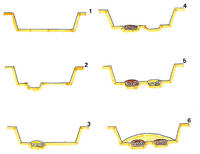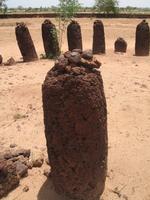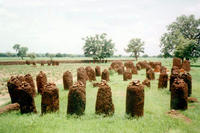You are in: Africa -> Gambia -> Stone Circles of Sen... , and traditional search or Image Gallery will yield results of this site only
Stone Circles of Senegambia
| Site number: | 1226 |
|
| Type of site: | Cultural | |
| Date: | 3c.BC-16th c.AD | |
| Date of Inscription: | 2003 | |
| Location: | Africa, Gambia and Senegal, Central River Division - Gambia, Kaolack Region – Senegal | |
Up to 75 images are shown here. Click on each for more details or on Image Gallery for more images.
| Description: | The site comprises of four large stone circle groups that encompass an incomparable cluster of over 1,000 monuments in a 100 km wide band along 350 km of the River Gambia. The four groups (Sine Ngayène, Wanar, Wassu and Kerbatch) consist of 93 stone circles and numerous tumuli, and burial mounds; excavations have uncovered material dating between 3rd century BC and 16th century AD. The stone circles of laterite pillars and the related burial mounds exhibit an immense sacred landscape aged 1,500 years. The site reveals an affluent, highly organized and lasting society. Having been quarried with iron tools and skillfully shaped into more or less duplicate cylindrical or polygonal seven-ton pillars, the stones on average reach about two metres in height. The circles, each containing between 8 and 14 pillars, are 4 to 6 metres across all located in close proximity to the burial mounds. This outstanding site is part of a wider megalithic zone in the region, which in its size, consistency, and complexity seems to be have no other match in the world. Each stone is finely worked displaying clear-cut and skillful working practices, contributing to the striking order and grandeur of the overall complexes. --WHMNet paraphrase from the description at WHC Site, where additional information is available. | |
| The Senegambian stone circles lie in Gambia north of Janjanbureh and in central Senegal. Coordinates: 13° 41 N - 15° 31 W. Approximate area: 15,000 square miles (39,000 km²). They are sometimes divided into the Wassu (Gambian) and Sine-Saloum (Senegalese) circles, but this is purely a national division. The stones were erected around the eighth century on top of earlier graves. The ten to twenty-four stones in each circle vary in size up to ten-ton stones, from 1 to 2.5 metres high and are generally of laterite. The stones mark burials and were erected before the twelfth century. There are around 1,000 stone circles, the biggest concentration being more than 1,000 stones in fifty-two circles at Djalloumbéré and those around the village of Wassu, which has a museum devoted to them. One notable circle is actually a V formation. Traditionally, for unknown reasons, people leave small rocks on the stones. The use to which the stones were put is not clear but recent excavation work (2006), reported by the National Geographic Society, suggests a funerary purpose given the large number of human remains found at the sites. Archaeologists at the site are pursuing the theory that different parts of a body were buried at different sites and at different times. A National Geographic podcast is available at. Select the episode entitled 'Senegal: Monuments', dated 11 August 2006 (if your browser does not have a RSS 'news reader' built-in, then copy the link into iTunes and subscribe to the feed). --Wikipedia. Text is available under the Creative Commons Attribution-ShareAlike License. | ||
| Source: | http://whc.unesco.org/en/list/1226 | |
| Reference: | 1. UNESCO World Heritage Center, Site Page. | |












